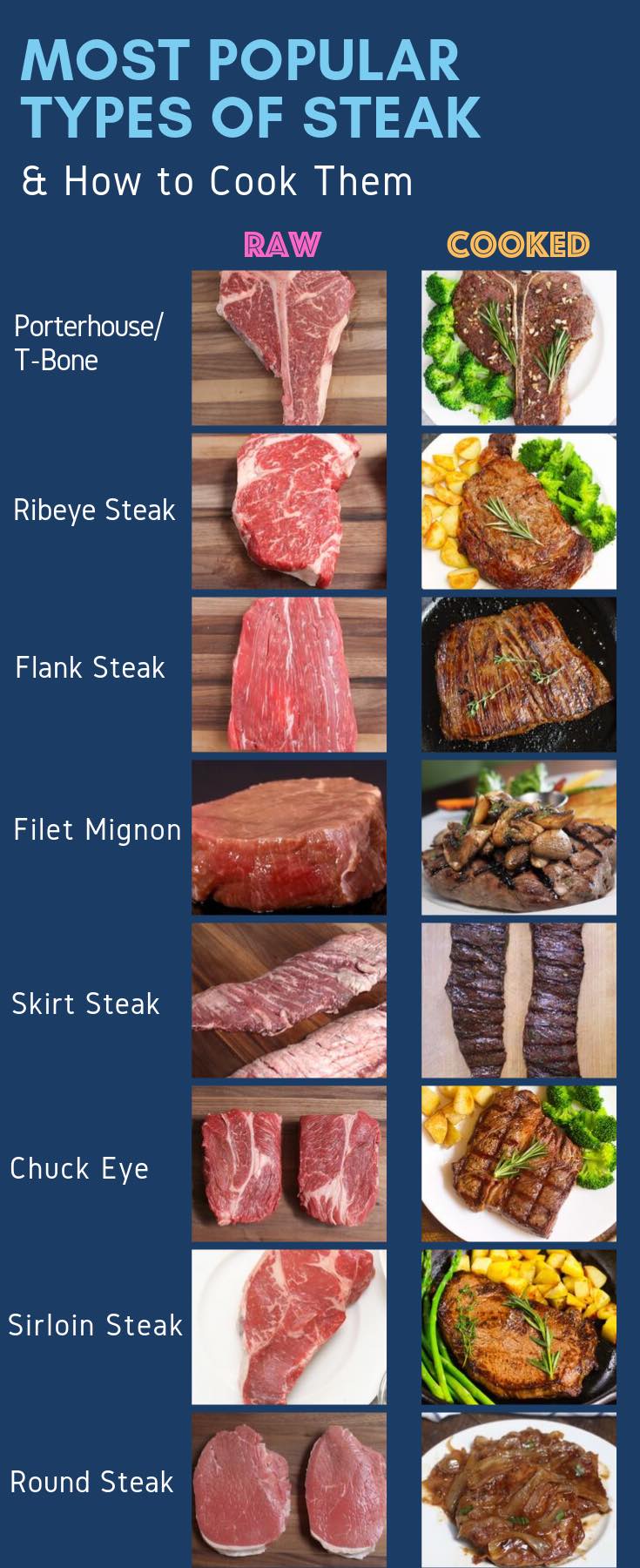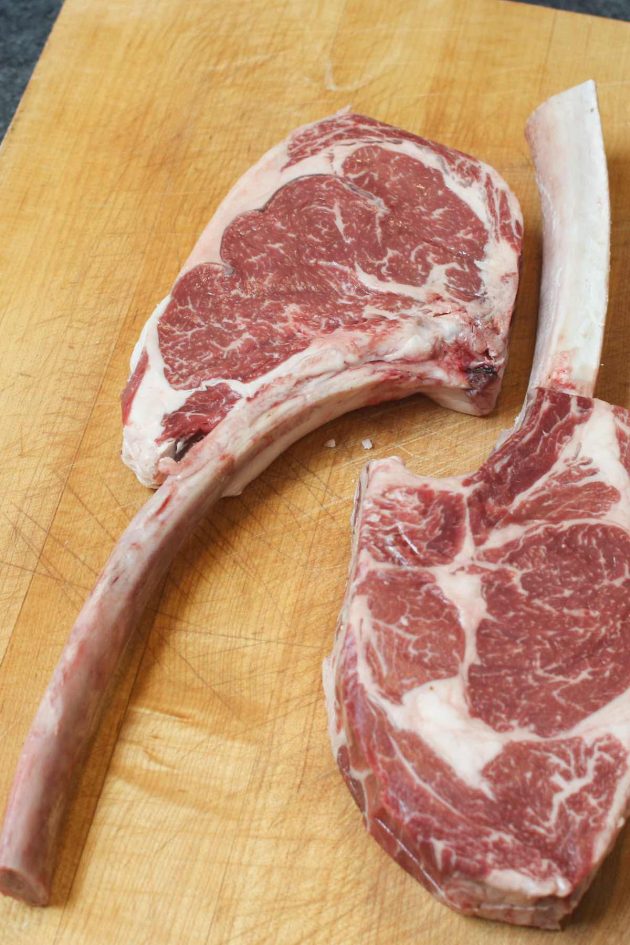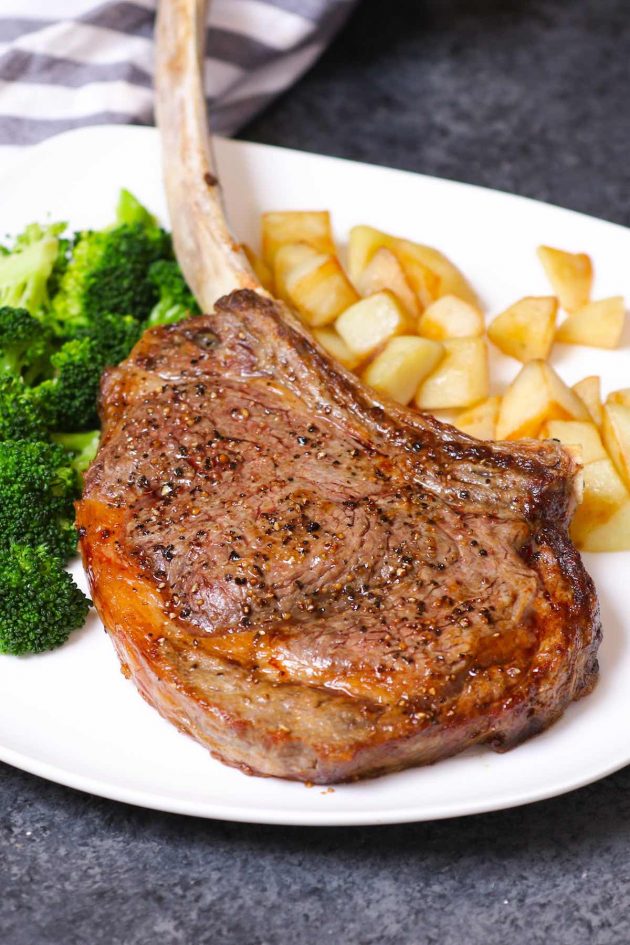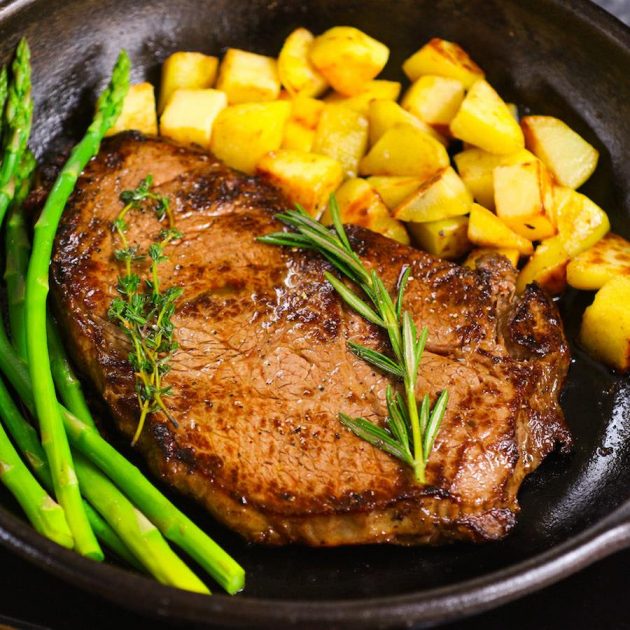12 Different Types of Steak
This post may contain affiliate links. Please read the disclosure policy.
There’s nothing better than a steak dinner, but understanding the many different types of steak can be confusing! Knowing how to choose the best steak cuts by tenderness, flavor and price is all part of preparation. From porterhouse to flank steak, this guide covers the most common types of steak and how to cook each cut to perfection!

What is A Steak?
A steak is a popular cut of meat that is sliced across the muscle fibers and includes a bone in some cases. Beef steaks are typically ½-inch to 2 inches thick and can be cooked many ways including grilling, pan frying, oven baking, broiling, sous vide and more. Popular steak cuts include ribeye, sirloin, filet mignon and T-bone.
What Makes a Great Steak?
The best types of steak are tender, juicy and well-marbled, since nobody enjoys dry and chewy meat. Fat is the main flavor component in steak. Beef quality is therefore graded for tenderness, juiciness, and flavor according to USDA Meat Grades. Muscles getting less use are usually more marbled and tender, so the best cuts are in the center of the cow, mainly the rib and loin sections.
There are 3 levels according to USDA’s beef grades:
- Prime grade comes from young, well-fed cows with abundant marbling, and it’s often sold to restaurants and hotels.
- Choice grade is high quality with less marbling than prime and is often sold to supermarkets.
- Select grade is very uniform in quality and normally leaner than the higher grades.
Best Cuts of Steak
The best and most expensive cuts of steak are from the center of the steer, which is the loin or rib section. The USDA divides a cow into 8 sections (chuck, rib, loin, round, flank, short plate, brisket, and shank), known as the primal cuts. This Beef Cuts Chart will help you easily understand everything you see at the grocery store.
The best cuts of steak include:
- Tenderloin: for its highest level of tenderness.
- Porterhouse and T-bone Steak: for combining two prime cuts in one piece.
- Ribeye: for its well-marbled, juicy and extremely flavorful meat.
- New York Strip: for one of the most flavorful cuts featuring a milder taste.

Different Types of Steak
This post is focusing on beef steaks, although pork steaks, fish steaks etc. also exist. The USDA divides a cow into 8 sections that are known as the primal cuts, which are once again divided into sub-primal cuts. The butcher works with sub-primal cuts and slices them into steaks and other subdivisions.
Beef steaks are mostly cut perpendicular to the muscle fibers from a large section of a cow, and may or may not include a bone.
Each type of steak comes from different cuts of a cow and has a “tenderness” rating according to BeefResearch.org.
1. Porterhouse / T-bone Steak


Porterhouse and T-bones are considered the highest quality steaks due to their tenderness and flavor. They have a T-shaped bone with a piece of tenderloin on one side and a strip of top loin steak on the other.
Porterhouse steaks are usually larger than T-bone steaks, and are considered the “king” of steaks. According to USDA regulations, the tenderloin section of a porterhouse must be wider than 1.25 inches (3cm) across its widest point. Anything from 0.5 to 1.24 inches (1.3-3cm) gets classified as a T-bone.
- Where they’re from: Porterhouse and T-bone are crosscut from the front of the short loin.
- Tenderness level: 8/10
- Flavor: Very flavorful with two types of steak per cut and moderate fat marbling throughout to keep the meat moist and juicy.
- Cost: Most expensive
- Calories: 420 calories per 6 oz (170 grams)
- Cooking method: Slightly more challenging to prepare since the tenderloin portion cooks faster than the strip section. The tenderloin should therefore be kept further away from the heat source when possible. They’re great for grilling, pan-frying and broiling. Thick cuts can be cooked in a cast-iron skillet over high heat and finished in the oven for a mouthwatering steak.
2. Filet Mignon (Tenderloin Steak)


Beef tenderloin or filet mignon is the most tender cut of beef. Filet mignon refers to steak, while beef tenderloin is also the name for the entire boneless roast.
- Where it’s from: Located in the short loin, the tenderloin is cut from the muscle on the back of a cow with the low exercise in that area keeping the muscle tender.
- Tenderness level: 9/10
- Flavor: As a lean cut without much marbling, tenderloin has a mild flavor with a buttery taste.
- Cost: Most expensive
- Calories: 454 calories per 6 oz (170 grams)
- Cooking method: Filet mignon is suitable for grilling, pan-searing and baking/broiling. The best way to cook the perfect filet mignon is by combining pan-searing at high temperature with an oven finish. The cast-iron skillet helps to sear the outside of the filet, while the oven’s indirect heat produces a slightly charred crust.
3. Ribeye


Also called Delmonico steak, beauty steak or scotch fillet, rib eye is one of the most prized steaks. The corresponding roast is the prime rib. Ribeye steaks are juicy, tender and very flavorful.
In the U.S., rib eye refers to a boneless rib steak, while in many other countries it means a bone-in cut.
- Where it’s from: Located in the rib section in the lightly-worked upper cage area.
- Tenderness level: 8/10
- Flavor: Ribeye steak is extremely flavorful with high fat content. Usually well-marbled and very tender.
- Cost: Expensive
- Calories: 582 calories per 6 oz (170 grams)
- Cooking method: This cut is easy to cook and suitable for pan-frying, broiling or grilling. Plus, it’s the original cut for the iconic Philly Cheese Steak.
4. Tomahawk


Tomahawk steak is a cut of beef ribeye that has the whole rib bone attached, and it’s sometimes called a cowboy steak or bone-in ribeye. The main difference from a ribeye is the visual presentation. Plus, a tomahawk is often cut over 2-inches (5cm) thick to accommodate the bone.
- Where it’s from: Cut from the rib section.
- Tenderness level: 8/10
- Flavor: Extremely flavorful with extensive marbling and high fat content.
- Cost: Expensive
- Cooking method: A Tomahawk requires special cooking due to its size and a thickness of 2 inches (5cm). The best approach is reverse-searing: baking or grilling first at low heat 200-275°F (93-135°C) and then searing at high temperature to finish.
5. Chuck Eye Steak


Chuck eye steak is also called “poor man’s rib eye”. It’s located very close to rib eye steaks and therefore shares many characteristics of a rib eye. There are only two chuck eye steaks per cow and it’s not always available.
- Where it’s from: Cut from the upper shoulder, chuck eye comes from the chuck primal section at the 5th rib, right next to the rib eye section in ribs 6-12.
- Tenderness level: 6.5/10
- Flavor: Reasonably flavorful, although somewhat less so than a rib eye.
- Cost: It’s a low-cost alternative to ribeye steak.
- Calories: 378 calories per 6 oz (170 grams)
- Cooking method: You can cook chuck eye steak the same way you would ribeye, but limit doneness to medium. It’s also a good idea to marinate the steak before cooking.
6. Flank Steak


Flank steak is a large, thin cut from the belly of the steer. It’s lean and flavorful meat. While flank isn’t a tender cut, it’s not the toughest either. Marinating will help to tenderize it while bringing out the best of its flavor.
- Where it’s from: It’s located in the flank section below the loin along the cow’s abdomen.
- Tenderness level: 5/10
- Flavor: One of the most flavorful steaks.
- Cost: Budget-friendly
- Calories: 326 calories per 6 oz (170 grams)
- Cooking method: It’s best to marinate flank steak, cook at high temperature and slice crosswise against the grain. It tastes best when cooked to medium-rare doneness, as it can be chewy if well done. Flank steak is the ideal cut for London Broil, and it’s great for Steak Sandwiches, Steak Tacos and stir-fry recipes.
7. Skirt Steak


Skirt steak is a long, thin cut from the diaphragm muscles of the steer, and it’s sometimes confused with flank steak for its fibrous appearance. Skirt steak is prized for its flavor and is one of the healthiest beef cuts.
- Where it’s from: It’s located in the outer section or “plate” of the diaphragm muscles, along with the hanger steak.
- Tenderness level: 3/10
- Flavor: Skirt steak has even stronger beefy flavor than flank steak.
- Cost: Budget-friendly
- Calories: 374 calories per 6 oz (170 grams)
- Cooking method: Skirt steak benefits from marinating before cooking at high temperature. For pan-frying or grilling, it should only be cooked rare to medium-rare to avoid getting a chewy texture. The traditional cut for Steak Fajitas, it’s also popular for stir-frying.
8. Sirloin Steak


Sirloin is one of the most popular steaks and is divided into two types: Top Sirloin and Bottom Sirloin. Top sirloin steak is the better cut and often labeled as Sirloin in the supermarkets. Bottom sirloin is larger and tougher!
- Where it’s from: Cut from the sirloin section where the T-bone, Porterhouse and club steaks come from.
- Tenderness level: 7/10
- Flavor: Top Sirloin steak is a tasty cut with beefy flavor coming from its higher fat content.
- Cost: Top Sirloin prices are above average but less than a Rib Eye or T-bone; Bottom Sirloin cuts are more affordable.
- Calories: 414 calories per 6 oz (170 grams)
- Cooking method: High-temperature cooking including pan-frying, broiling and grilling.
9. New York Strip
A New York Strip steak is a particular cut of Top Sirloin, and it’s sometimes called Strip Loin, Top Sirloin or Top Loin Steak. New York strip has a unique mild flavor, although its texture is slightly grainier than other premium cuts such as ribeye or filet mignon.
NY strip is typically a boneless piece. When a bone is attached to the strip, it is called Kansas City Strip or Bone-in New York.
- Where it’s from: Top part of the sirloin.
- Tenderness level: 7/10
- Flavor: Very juicy and flavorful with a strong beefy taste; more tender than most cuts with moderate marbling.
- Cost: Expensive
- Cooking method: As with sirloin, it’s suitable for high-temperature cooking including pan-frying, broiling, or grilling.
10. Tri-tip Steak
Tri-tip is also a particular cut of sirloin steak. It’s a boneless cut about 3/4 to 2 inches thick coming from a large triangular section of bottom sirloin. Other names include Triangle Steak, Bottom Sirloin Steak, or Santa Maria Steak.
- Where it’s from: Located at the bottom end of sirloin, next to the flank and rump.
- Tenderness level: 6/10
- Flavor: Although less flavorful than top sirloin, tri-tip is a good cut of meat with relatively rich beef flavors. It’s also leaner than top sirloin, making it a healthier choice.
- Cost: Budget-friendly
- Calories: 316 calories per 6 oz (170 grams)
- Cooking method: Marinate tri-tip and then cook at high temperature. Grilling and broiling are ideal for cooking this cut of steak.
11. Round Steak


Also called topside and silverside, round steak is divided into several cuts such as the eye of round, bottom round and top round (which is sometimes called London broil). Round steak comes from well-exercised muscles and consequently quite lean.
- Where it’s from: The “round” in the rear leg of the cow.
- Tenderness level: 4/10
- Flavor: Round steak is very flavorful and beefy but needs to be marinated or braised.
- Cost: Budget-friendly
- Calories: 310 calories per 6 oz (170 grams)
- Cooking method: It’s most suitable for braising or slow-cooking at low heat.
12. Flat Iron Steak
Flat iron steak is a popular cut with near-perfect marbling that makes it second only to filet mignon in tenderness. Flavorful and easy to prepare, it also goes by the names Boneless Top Chuck Steak, Butler Steak and Oyster Blade Steak.
- Where it’s from: Cut from chuck in the shoulder of the cow.
- Tenderness level: 8/10
- Flavor: Richly flavored and juicy
- Cost: Budget-friendly
- Calories: 233 calories per 6 oz (170 grams)
- Cooking method: High-temperature cooking including grilling, pan-frying and broiling.

What is London Broil?
London broil is a dish named after a cooking method whereby flank steak or round steak is marinated before being broiled or grilled. The cooked meat is then sliced against the grain and served as strips. In spite of the name, London broil is American and also referred to as Dawson in the South.
What is Rump Steak?
Rump steak refers to several different beef cuts. In the US, it typically means the upper half of the round steak primal. In the UK and Commonwealth countries, it refers to a steak from the rump primal, which is equivalent to American top sirloin. These cuts are flavorful and leaner with a characteristic strip of fat on one side.
What is a Denver Cut?
The Denver cut refers to a rectangular steak coming from the center of the shoulder under-blade section of the chuck primal. Unlike most chuck steaks, this cut’s serratis ventralis muscle has extensive marbling, making it the forth most tender cut of beef even if the texture is somewhat different from a traditional steak.
The cut was the winner of a Cattleman’s Beef Board competition held in Colorado, hence the name. While this cut is rarely available in supermarkets, any local butcher can produce it easily.
What is Cube Steak (Minute Steak)?
Cube steak, also known as minute steak, is a thin cut of beef that has been mechanically tenderized. The process of tenderizing the meat breaks down the tough muscle fibers and connective tissue, resulting in a more tender texture.
The name “cube steak” reflects how the meat is typically scored with a cross-hatch pattern, which looks like a series of cubes. Cube steak is commonly used in dishes such as chicken-fried steak, Salisbury steak, and Swiss steak as well as fajitas.
What is Hanger Steak?
Hanger steak is a flavorful and tender cut of beef that comes from the muscle that hangs between the rib and the loin of the cow. The hanger steak is located in the diaphragm of the cow and is typically elongated and thin, with a pronounced grain. It has a rich, beefy flavor and a slightly chewy texture, taking well to marinades and being suitable for recipes such as fajitas. It is a cut favored by butchers for being flavorful and affordable.

Cooking Different Types of Steak
Tender cuts: these types of steaks are excellent for cooking at high temperatures using dry heat such as grilling, broiling, pan-frying and baking. Examples include Porterhouse, T-bone, Ribeye and New York Strip. You can cook thin cuts (up to 1 1/2 inches thick) using direct heat only. However, if your steak is thicker you may want to use a reverse sear to combine direct high heat with lower indirect heat.
Cuts with a medium level of tenderness and marbling: these cuts of steaks should be marinated before cooking at high temperature and limited to medium doneness. Examples include Flank Steak and Skirt Steak.
Lean and tough cuts: use low-and-slow cooking for these cuts such as Round Steak.
Tips for Making Steak Tender and Juicy
For cooking center-cut steaks on the grill, stove or oven, here are some tips to ensure tender steak every time:
- Choose thicker steaks for maximum tenderness.
- Use room temperature steaks for even cooking, especially for thicker cuts.
- Pat dry the steak before cooking to help get a good sear.
- Marinate tougher cuts before cooking to help tenderize the meat.
- Cook thick cuts on indirect heat (less than 275°F/135°C) and finish on direct high heat (450°F /232°C).
- Use an instant-read thermometer to check internal temperatures and avoid overcooking.
- Rest your steak for 5-10 minutes covered with foil or a plate after grilling, allowing juices to retreat back into the steak for maximum tenderness.
- Cut against the grain when serving.
Degrees of Steak Doneness
The most accurate way to check steak doneness is by inserting an instant-read thermometer into the middle of the steak. Follow the guidelines on this steak doneness chart:
| Doneness | Remove from Heat | Final Internal Temp |
| Rare (cool red center) | 120°F (49°C) | 125°F (52°C) |
| Medium-rare (warm red center) | 130°F (54°C) | 135°F (57°C) |
| Medium (warm pink center) | 140°F (60°C) | 145°F (63°C) |
| Medium-well (pale pink center) | 145°F (63°C) | 150°F (66°C) |
| Well Done (little pink) | 155°F (68°C) | 160°F (71°C) |
Note: a steak’s internal temperature typically rises 5°F (3°C) while resting.

FAQ
What are the top 5 most tender steaks?
The top-5 most tender steaks according to Texas A&M Meat Science are: filet mignon (also known as tenderloin), ribeye, New York strip (striploin), T-bone and Porterhouse. Sometimes top blade or Denver steaks are mentioned, although they are less common cuts.
What are some good side dishes for steak?
You can serve steak with potatoes, vegetables and steak sauce if you like. Other side dish pairings to consider include: Balsamic Brussels Sprouts, Steamed Broccoli, Boiled Corn, Roasted Parsnips, Mango Salad, Blooming Onion.
What to look for when buying steaks?
If you’re buying steaks at a local grocery store, here are a few tips for choosing a good cut:
- Color: fresh steak is bright red or purplish-red. Brown spots are a sign of old steaks.
- Marbling: Look for steaks that are well-marbled, since marbling affects tenderness, moistness and flavor.
- Moisture: the less moisture in the package, the fresher the steak.
- Grade: USDA grades beef according to the quality. Prime is the highest grade, followed by Choice and Select.
- “Sell by date”: make sure to purchase a steak before its sell-by-date.
What are the best wines to pair with steak?
Cabernet Sauvignon is often the number one choice for steak. California Zinfandel has moderate tannins and high acidity, making it great for pairing with Porterhouse, T-bone and Ribeye steaks. Other good red wine choices include Malbec, Syrah, Sangiovese, and Chianti. Chilled Rosé wine or bubbly Sparkling wine is a great pairing too.
Watch Video: 5 Easy Steak Recipes
How to Cook Different Types of Steak
Ingredients
Tender Cuts (T-Bone, Ribeye, Filet Mignon, Top Sirloin etc.)
- 2 pounds steak, cut at least 1 inch thick
- 2 tablespoons canola oil, or other high-temperature oil
- 1 teaspoon salt
- 1 teaspoon pepper
- fresh rosemary or thyme, optional
Less Tender and Tougher Cuts (Flank, Skirt, Sirloin Tip etc.)
- 2 pounds steak
- 1/3 cup soy sauce
- 2 tablespoons honey
- ½ cup canola oil, or other high-temperature oil
- 2 tablespoons Worchestershire sauce
- 1 tablespoon lime juice, or balsamic vinegar
Instructions
Tender Cuts (T-Bone, Ribeye, Filet Mignon, Top Sirloin etc.)
- Remove the steaks from the fridge 30 minutes before cooking to warm slightly.
- Preheat your oven or grill to 400 deg F. Place a cast iron pan on high heat for 5 minutes until very hot. Turn on the ventilation exhaust fan.
- Meanwhile, pat dry the meat with paper towels to remove excess moisture. Rub with oil on all sides and season with salt and pepper.
- Place the steak in the cast iron pan and sear for 2 minutes undisturbed. Using kitchen tongs, flip the steak and sear 2 minutes more.
- Transfer the pan to the oven to finish cooking until desired doneness is reached. Or if you prefer, continue cooking on the stovetop, flipping every minute for even cooking.
- Remove the steak to a plate and let it rest for 5 minutes covered with foil. Slice against the grain to serve. (This steps allows the juices can redistribute through the meat for maximum tenderness.)
Less Tender and Tougher Cuts (Flank, Skirt, Sirloin Tip etc.)
- In a medium bowl, whisk together the oil, soy sauce, honey, Worcestershire sauce and lime juice/vinegar.
- Add the steak to the marinade and turn several times to coat thoroughly.
- Cover with plastic wrap and place in the fridge to marinate for up to 4 hours.
- Remove the bowl from the fridge and let it rest at room temperature for 30 minutes.
- Preheat your oven or grill to 400 deg F. Place a cast iron pan on high heat for 5 minutes until very hot. Turn on the ventilation exhaust fan.
- Meanwhile, remove the meat from the marinade and scrape off all excess with a spoon.
- Place the steak in the cast iron pan and sear for 2 minutes undisturbed. Using kitchen tongs, flip the steak and sear 2 minutes more.
- Transfer the pan to the oven to finish cooking until desired doneness is reached. Or if you prefer, continue cooking on the stovetop, flipping every minute for even cooking.
- Remove the steak to a plate and let it rest for 5 minutes covered with foil. Slice against the grain to serve. (This steps allows the juices can redistribute through the meat for maximum tenderness.)
Notes
- For very tough cuts such as round steak, braising in a Dutch oven or crock pot is recommended. Sear over high heat for 2 minutes per side to brown the meat. Add the marinade ingredients to the crock pot and cook for 3 hours on Low until tender. Drizzle juices from the crock pot on the steak to serve.
Please read our nutrition disclaimer.
© TIPBUZZ. Images and text on this website are copyright protected. Please do not post or republish without permission. If you want to republish this recipe, please link back to this post. This post may contain affiliate links. Read the disclosure policy here.








This looks so yummy i would love to try one for my family
Hi Telma, Thanks for your feedback and hope you enjoy!
This was so helpful when trying to choose the right steak to buy and cook!
Hi Ashley, Great to hear that and thanks for your comment!